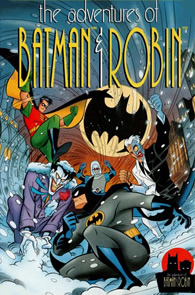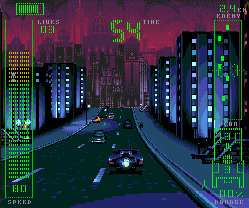To many Genesis owners, The Adventures of Batman & Robin exemplifies just how much can be done on the console. Incredible special effects and some of the most challenging gameplay  around have cemented its place as a title worthy of a special place in gaming libraries, and fans still marvel today at a game that puts the Genesis through its paces like no other since Gunstar Heroes.
around have cemented its place as a title worthy of a special place in gaming libraries, and fans still marvel today at a game that puts the Genesis through its paces like no other since Gunstar Heroes.
Adventures was the product of Clockwork Tortoise, a group of young artists, designers, and programmers that set out to make the Genesis work like everyone knew it could. Though the company only lasted for a short amount of time, the impact it made is still felt by anyone who owns one of Sega’s little black boxes and enjoys one of the best games of the 16-bit era.
Sega-16 recently spoke to former Clockwork Tortoise artist Chris George, who shared some delightful tales of what it was like to be a young kid working at one of the greatest software publishers of all time.
Sega-16: You started at Sega at a very young age, and diving into the video game industry must have been the stuff of dreams. Did you ever feel intimidated by all the experienced people making games around you?
Chris George: My first job was at a small studio called Malibu Interactive, where for a short time I worked on a few unreleased games based on licenses from Malibu Comics. A group of guys from Malibu had just left to start their own company called Clockwork Tortoise, and I went to go work for them shortly after they landed the Batman and Robin project from Sega. I was a bit of an outgoing seventeen year-old, so I never felt very intimidated. Also, I had the opportunity to work with some extremely talented guys who were more than willing to help me get accustomed to how things worked in the industry.
Sega-16: What lessons did you learn from them?
Chris George: One of the best learning situations I was in was during my first few months in the industry at Malibu. An artist there named Chris Senn was totally cool with me sitting next to him all day simply watching him create art for Genesis games. He was creating graphics for Battletech at the time, which I loved. Being in that situation really put my career on the fast track.
After leaving Malibu to work for Clockwork Tortoise, I had the privilege of working with Steve Thomson, probably one of the most talented pixel artists of the 16-bit era. I learned so much from simply looking at the stuff he created.
Sega-16: Did you ever get a chance to swap ideas with anyone famous, like Yuji Naka or Mark Cerny?
Chris George: No famous game designers came around our offices back then unfortunately. Most of my experiences with “famous” guys in the industry were with the suits from Sega. I was once in on a meeting about the progress of Batman and Robin with Tom Kalinske. Sega was pretty upset with us for being over six months late delivering the game, and I think Tom was invited to the meeting to invoke fear. At eighteen years-old, I don’t think I realized how serious the situation was.
Sega-16: You were at Clockwork Tortoise for only about a year. What happened to it? Was it a victim of the transition to 3D, or was it just dissolved by Sega as a cost-cutting measure?
Chris George: Clockwork Tortoise was the victim of itself. The guys who started the company were extremely talented and capable, but were lacking organization. After a couple of years of working all-nighters, the lead programmer decided he was done and moved back to Ireland to start a coffee house. I left before that happened because they were moving the company to San Francisco, which would have put me in a situation where I would have broken up with my girlfriend, who was still in high school. Seems like a pretty juvenile reason to take a risk with a young career, but there were plenty of companies in the LA area, and I ended up marrying that girl a few years ago. 🙂
 Sega-16: The Adventures of Batman & Robin has been hailed as one of the best examples of how to squeeze every last ounce of power out of the Genesis, something few developers (especially third party ones) were ever able to achieve. Did Clockwork Tortoise have access to any special tools or kits that allowed them to achieve such great results, or did it all just come from incredible programming and design?
Sega-16: The Adventures of Batman & Robin has been hailed as one of the best examples of how to squeeze every last ounce of power out of the Genesis, something few developers (especially third party ones) were ever able to achieve. Did Clockwork Tortoise have access to any special tools or kits that allowed them to achieve such great results, or did it all just come from incredible programming and design?
Chris George: All of the technical achievements in Batman and Robin were due to the programming prowess of John O’Brien, the lead programmer at Clockwork. His technical abilities actually drove the game design. He would make some amazing effect, and we would find a way to showcase it in the game. I think half of the bosses in the game were initially his idea, because he would think of some cool effect.
Sega-16: Batman’s rogues gallery is so well known, and it must have been difficult to convey such powerful personalities with the limited hardware of the time. What was your greatest challenge in drawing these characters on the Genesis so that they remained true to their comic personas?
Chris George: It helps when Sega hires the Japanese animation studio responsible for some of the best episodes of the series to hand-draw all the animation frames for the Batman and Robin characters. We would scan them in, and I was responsible for going over them frame-by-frame to turn the scanned drawings into sprites. One of the surprising parts of this was that the animation studio actually sent us all the frames (thousands of them) as original pencil drawings instead of photo-copies. To this day, I still have each and every one of those hand-drawn pages.
Sega-16: By the time Adventures was released, the Genesis was getting pretty long in the tooth. Did the aging hardware cause any of your ideas to be left on the cutting room floor?
Chris George: I don’t think so. Most of the ideas that were cut from the game were due to the fact we were so late in delivering the game to the market.
Sega-16: The Sega CD version bears little resemblance to its cartridge cousin. Why weren’t you as involved in its development?
Chris George: John O’Brien was the lead programmer on Batman Returns for the Sega CD, which by no coincidence is extremely similar to Batman and Robin from Clockwork. The Sega CD Adventures game was in a large part just a repackaged version of that game. I was hired to create character sprites, and the sprites on the Sega CD version were almost entirely vehicles. The company expanded by hiring two new artists and one programmer to make that game.
Sega-16: History notes Sega’s internal battles around the time you were there. Did any of it ever affect your work? Did management offer any feedback?
 Chris George: The lead producer at Clockwork Tortoise had this talent for turning our shortcomings back around on Sega. They would call to complain we missed a milestone and to inform us that payment wouldn’t be made until we made the milestone’s requirements. His response was that we’d stop working if they didn’t send a check immediately. Since so much had been invested in the title at this point, we always got the checks and almost never delivered a proper milestone. The industry certainly doesn’t function in this manner anymore.
Chris George: The lead producer at Clockwork Tortoise had this talent for turning our shortcomings back around on Sega. They would call to complain we missed a milestone and to inform us that payment wouldn’t be made until we made the milestone’s requirements. His response was that we’d stop working if they didn’t send a check immediately. Since so much had been invested in the title at this point, we always got the checks and almost never delivered a proper milestone. The industry certainly doesn’t function in this manner anymore.
Sega-16: Both games were released at a time when the 16-bit era was winding down, and they were lost under all the pre-Saturn, PlayStation, and N64 hype. What do you want gamers to remember most about these two landmark titles?
Chris George: Well, everyone that remembers the Genesis game only ever comments on the difficulty. 🙂 I think the memorable graphics and boss characters are the parts of the game I look back with the most pride. One of the pieces of the game that I’m most proud of was the Chesire Cat boss. It was the only boss character that the Art Director let me do the art for. I busted my butt for that one and I think it paid off.
Sega-16 would like to thank Mr. George for his time.

Recent Comments